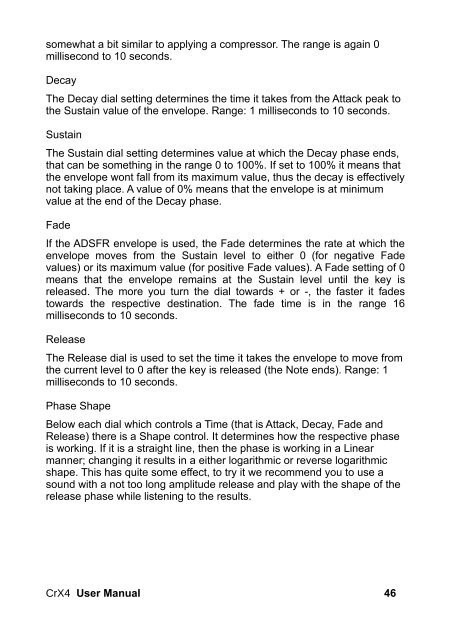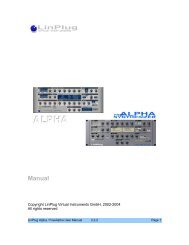CrX4 User Manual - LinPlug Virtual Instruments
CrX4 User Manual - LinPlug Virtual Instruments
CrX4 User Manual - LinPlug Virtual Instruments
You also want an ePaper? Increase the reach of your titles
YUMPU automatically turns print PDFs into web optimized ePapers that Google loves.
somewhat a bit similar to applying a compressor. The range is again 0<br />
millisecond to 10 seconds.<br />
Decay<br />
The Decay dial setting determines the time it takes from the Attack peak to<br />
the Sustain value of the envelope. Range: 1 milliseconds to 10 seconds.<br />
Sustain<br />
The Sustain dial setting determines value at which the Decay phase ends,<br />
that can be something in the range 0 to 100%. If set to 100% it means that<br />
the envelope wont fall from its maximum value, thus the decay is effectively<br />
not taking place. A value of 0% means that the envelope is at minimum<br />
value at the end of the Decay phase.<br />
Fade<br />
If the ADSFR envelope is used, the Fade determines the rate at which the<br />
envelope moves from the Sustain level to either 0 (for negative Fade<br />
values) or its maximum value (for positive Fade values). A Fade setting of 0<br />
means that the envelope remains at the Sustain level until the key is<br />
released. The more you turn the dial towards + or -, the faster it fades<br />
towards the respective destination. The fade time is in the range 16<br />
milliseconds to 10 seconds.<br />
Release<br />
The Release dial is used to set the time it takes the envelope to move from<br />
the current level to 0 after the key is released (the Note ends). Range: 1<br />
milliseconds to 10 seconds.<br />
Phase Shape<br />
Below each dial which controls a Time (that is Attack, Decay, Fade and<br />
Release) there is a Shape control. It determines how the respective phase<br />
is working. If it is a straight line, then the phase is working in a Linear<br />
manner; changing it results in a either logarithmic or reverse logarithmic<br />
shape. This has quite some effect, to try it we recommend you to use a<br />
sound with a not too long amplitude release and play with the shape of the<br />
release phase while listening to the results.<br />
<strong>CrX4</strong> <strong>User</strong> <strong>Manual</strong> 46












